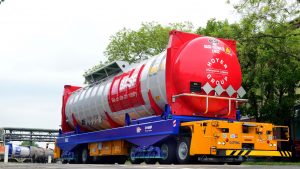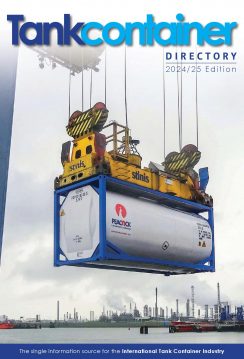BASF, the world's second-largest chemicals producer, has an 'integrated logistics concept' that could have far-reaching implications for the tank container sector, reports Brian Dixon
From container terminals to dangerous goods warehouses, the rate of automation and digitalisation is accelerating at breakneck speed. Admittedly, we may not yet all have personal jetpacks and flying cars but things are looking increasingly futuristic nonetheless, with German chemical giant BASF very much leading the way when it comes to bringing this real-life sci-fi to the world of tank containers.
But while the thrust of much recent technological advancement has been to miniaturise things, preferably down to the nanoscale if possible, BASF's tank container fleet has very much gone the other way with the ongoing deployment of 45' and 52' 'rail-optimised' units for use both within and beyond its immense home site in Ludwigshafen.
Developed in conjunction with Belgium's Van Hool over a two-year period, and suitably known as BASF-class tank containers (B-TCs), these mega tanks were first launched in 2017 and have filling capacities of 53-63,000 litres and 73,000 litres. As such, their handling capacities are, in BASF's words, "double that of today's typical tank containers and similar to that of a chemical rail tank car". However, unlike rail tanks, these units are able to marry the benefits of bigger bulk consignments with the logistical flexibility of conventional 20' and 30' tank containers.
Indeed, the B-TC can not only "be transported on any kind of railway track", but they can also be transported via inland waterways and also, when empty, by road. They also require considerably less rail infrastructure than conventional rail tanks; offer greater flexibility in loading and unloading; and can be stacked six-units high when filled, meaning that they can also be used for liquid storage (something that can be further enhanced with the application of modern insulation and heating capabilities). As these units can be quickly removed from a container wagon, they are also easier to clean and repair.
To read this article please go to:- https://www.tankcontainermedia.com/subscribe/ April 7, 2020
From container terminals to dangerous goods warehouses, the rate of automation and digitalisation is accelerating at breakneck speed. Admittedly, we may not yet all have personal jetpacks and flying cars but things are looking increasingly futuristic nonetheless, with German chemical giant BASF very much leading the way when it comes to bringing this real-life sci-fi to the world of tank containers.
But while the thrust of much recent technological advancement has been to miniaturise things, preferably down to the nanoscale if possible, BASF's tank container fleet has very much gone the other way with the ongoing deployment of 45' and 52' 'rail-optimised' units for use both within and beyond its immense home site in Ludwigshafen.
Developed in conjunction with Belgium's Van Hool over a two-year period, and suitably known as BASF-class tank containers (B-TCs), these mega tanks were first launched in 2017 and have filling capacities of 53-63,000 litres and 73,000 litres. As such, their handling capacities are, in BASF's words, "double that of today's typical tank containers and similar to that of a chemical rail tank car". However, unlike rail tanks, these units are able to marry the benefits of bigger bulk consignments with the logistical flexibility of conventional 20' and 30' tank containers.
Indeed, the B-TC can not only "be transported on any kind of railway track", but they can also be transported via inland waterways and also, when empty, by road. They also require considerably less rail infrastructure than conventional rail tanks; offer greater flexibility in loading and unloading; and can be stacked six-units high when filled, meaning that they can also be used for liquid storage (something that can be further enhanced with the application of modern insulation and heating capabilities). As these units can be quickly removed from a container wagon, they are also easier to clean and repair.
To read this article please go to:- https://www.tankcontainermedia.com/subscribe/ April 7, 2020
You currently do not have access to this article, please login or register to read more.
Login to read more






